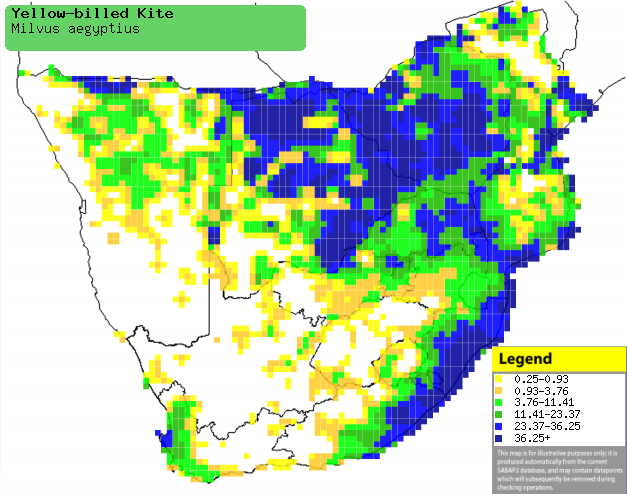|
Milvus aegyptius (Yellow-billed
kite)
[= Milvus (migrans) migrans]
Geelbekwou, Swartwou [Afrikaans]; Zwarte wouw [Dutch];
Milan d'Afrique [French]; Schmarotzermilan [German]; Milhafre-preto
[Portuguese]
Life
> Eukaryotes >
Opisthokonta
> Metazoa (animals) >
Bilateria >
Deuterostomia > Chordata >
Craniata > Vertebrata (vertebrates) > Gnathostomata (jawed
vertebrates) > Teleostomi (teleost fish) > Osteichthyes (bony fish) > Class:
Sarcopterygii (lobe-finned
fish) > Stegocephalia (terrestrial
vertebrates) > Tetrapoda
(four-legged vertebrates) > Reptiliomorpha > Amniota >
Reptilia (reptiles) >
Romeriida > Diapsida > Archosauromorpha > Archosauria >
Dinosauria
(dinosaurs) > Saurischia > Theropoda (bipedal predatory dinosaurs) >
Coelurosauria > Maniraptora > Aves
(birds) > Order: Falconiformes
> Family: Accipitridae
Distribution and habitat
Occurs across sub-Saharan Africa; in southern Africa it is common across much of the region, largely
excluding the Karoo, Kahalari and Namib Desert. It can be found in a wide
variety of habitats, but it especially favours woodland and rural areas (with a high human
population).
|
 |
|
Distribution of Black kite in southern Africa,
based on statistical smoothing of the records from first SA Bird Atlas
Project (©
Animal Demography unit, University of
Cape Town; smoothing by Birgit Erni and Francesca Little). Colours range
from dark blue (most common) through to yellow (least common).
See here for the latest distribution
from the SABAP2. |
Movements and migrations
Intra-African breeding migrant, arriving in
southern Africa from August-October and departing in March.
Food
It eats a wide variety of animals, typically searching for
prey aerially; it uses the style of flight characteristic of kites, as it
swivels its tail horizontally to steer accurately. Once it spots something, it
rapidly swoops to the ground to catch the prey item. The Black kite and the
Yellow-billed kite can be grouped as one species, so the following list of
food items in its diet applies for both of them:
- Live prey
- birds
- rodents (Rodentia)
- lizards
- frogs
- Pyxicephalus adspersus (Bullfrog)
- Ptychadena supercilliaris (Savanna ridged frog)
- fish (caught in shallow water)
- molluscs
- crustaceans
- insects
- Scavenged animals
Breeding
- Monogamous, territorial solitary nester, performing an elaborate courtship
display in which the male follows the female while calling and flying
acrobatically. The male then soars high up in the air
before it dives at the female, who rolls on her back to present her claws, so
that they can lock talons.
- The nest is built by both sexes, consisting of a bowl-shaped platform of
sticks which is lined with a variety of materials, such as skin, hair, dung,
paper, scraps of cloth or rarely green leaves. It is typically placed on the
main stem in the canopy of a large tree, such as Euphorbia.
- Egg-laying season is from August-December, peaking from
September-October.
- It lays 1-3 eggs, which are mainly incubated by the female for about
37-38 days; the male may take over so that the female can go out
to forage.
- The chicks are brooded constantly by the female for the first 5-6 days
of their lives, while the male provides all the food. When they become about
a month old the female helps him provide food for their young, who leave the
nest to clamber around the branches of the tree at about 40 days old, taking
their first flight a few days later.
Threats
Not threatened.
References
-
Hockey PAR, Dean WRJ and Ryan PG 2005. Roberts
- Birds of southern Africa, VIIth ed. The Trustees of the John Voelcker
Bird Book Fund, Cape Town.
|
